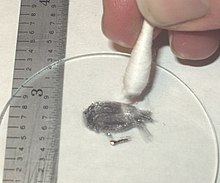Galinstan
Galinstan , a brand name , is a silvery, eutectic alloy of gallium , indium, and tin . Gal lium, In dium and Stan num ( latin for tin ) form the coined word galinstan. The alloy is liquid at room temperature and proceeds according to the manufacturer at temperatures below -19 ° C in the solid state of aggregation above. Galinstan adheres to many materials, including glass , which limits its applications. Thermometers can only be made with Galinstan if the inside of the tube is coated with gallium (III) oxide beforehand . Like mercury , Galinstan easily forms alloys with solid metals; for example, aluminum can be dissolved in Galinstan. Galinstan has a very high surface tension of 718.0 mN / m, in contrast to water with 72.75 mN / m and mercury with 476.0 mN / m (all at 20 ° C).
Composition and melting point
Expressed as a percentage by mass, Galinstan consists of 65 to 95% gallium, 5 to 22% indium and 0 to 11% tin. According to the manufacturer, the alloy of 68 to 69% gallium, 21 to 22% indium and 9.5 to 10.5% tin has a particularly low melting point at −19.5 ° C.
A similarly composed mixture of 62% gallium, 22% indium and 16% tin, on the other hand, has a melting point of 10.7 ° C.
A mixture of 68.5% gallium, 21.5% indium and 10% tin has a density of 6.4 g · cm −3 and a melting point of 11 ° C.
The ternary eutectic of these three elements with a composition of 59.6% gallium, 26% indium and 14.4% tin and a melting point of 11 ° C is also given in the physical-chemical literature .
The large deviation of the melting point between the values from the specialist literature and the manufacturer's information cannot be adequately explained with the sources available on the composition of the product.
properties
Galinstan is a silver-colored odorless liquid and has the following properties:
- Thermal volume expansion coefficient : 0.000126 K −1
- Density : 6.44 g cm −3
- Melting point : −19.5 ° C
- Boiling point :> 1300 ° C
- Vapor pressure : <10 −8 Torr (500 ° C)
- Solubility : insoluble in water and organic solvents
- Surface tension : 718.0 mN / m (20 ° C)
use
Galinstan is primarily used as a non-toxic substitute in many applications in which liquid mercury or sodium - potassium - eutectic ( NaK ) was used; Among other things as a lubricant in a high vacuum , for example in cathode ray tubes .
Galinstan can not because of its indium content as a coolant for nuclear reactors are used, because indium has a very high neutron capture - cross section , would be deprived of the reactor which too many neutrons.
As a metallic thermal paste for heat sinks with a thermal conductivity of 16 W / ( m · K ), it outperforms conventional thermal pastes with thermal conductivities of 1 to 9 W / (m · K). The disadvantage, however, is that aluminum heat sinks are dissolved by Galinstan, which is why it can only be used with (nickel-plated or non-nickel-plated) copper heat sinks. Unlike ordinary pastes, Galinstan is electrically conductive; Excess amounts can therefore cause short circuits if they swell out.
Since Galinstan is a liquid metal alloy, the use of Galinstan and other non-toxic liquid metals because of their malleability for flexible and stretchable electronics, for flexible switches and as thermal interface material (see also eng. thermal interface material).
Brand name
Galinstan is a legally protected brand name that was registered by Geratherm Medical AG on December 10, 1996 for "alloys consisting essentially of base metals, in particular gallium alloys" at the German Patent and Trademark Office .
Web links
Individual evidence
- ↑ a b Patent EP0657023 : Clinical Thermometer. Published on June 14, 1995 , inventors: Gerd Speckbrock, Siegbert Kamitz, Marion Alt, Heribert Schmitt.
- ↑ Hanan Chanaa: A new kind of metal electrode as an alternative to the mercury electrode: Galinstan in voltammetry . Berlin 2008, DNB 1023170396 , urn : nbn: de: kobv: 188-fudissthesis000000004871-5 (dissertation, FU Berlin).
- ↑ Data sheet Galinstan at AlfaAesar, accessed on December 15, 2010 ( PDF )(JavaScript required) .
- ↑ Information on goodfellow.com
- ↑ GN van Ingen, J. Kapteijn, JL Meijering: On the system Gallium-Indium-Tin . In: Scripta Metallurgica. 1970, Vol. 4, No. 9, pp. 733-736, doi: 10.1016 / 0036-9748 (70) 90215-2 .
- ↑ a b c d e MSDS Galinstan (manufacturer website) (PDF; 81 kB)
- ↑ Suqing Liang, Yaoyao Li Yuzhen Chen Jinbin Yang, Zhu Taipeng: Liquid metal sponges for Mechanically durable, all-soft, electrical conductors . In: Journal of Materials Chemistry C . tape 5 , no. 7 , 2017, ISSN 2050-7526 , p. 1586-1590 , doi : 10.1039 / c6tc05358k .
- ↑ Yuzhen Chen, Tingjiao Zhou, Yaoyao Li, Lifei Zhu, Stephan Handschuh-Wang: Robust Fabrication of Nonstick, Noncorrosive, Conductive Graphene-Coated Liquid Metal Droplets for Droplet-Based, Floating Electrodes . In: Advanced Functional Materials . tape 28 , no. 8 , January 15, 2018, ISSN 1616-301X , p. 1706277 , doi : 10.1002 / adfm.201706277 .
- ↑ Michael D. Bartlett, Navid Kazem, Matthew J. Powell-Palm, Xiaonan Huang, Wenhuan Sun: High thermal conductivity in soft elastomers with elongated liquid metal inclusions . In: Proceedings of the National Academy of Sciences . tape 114 , no. 9 , February 13, 2017, ISSN 0027-8424 , p. 2143-2148 , doi : 10.1073 / pnas.1616377114 .

